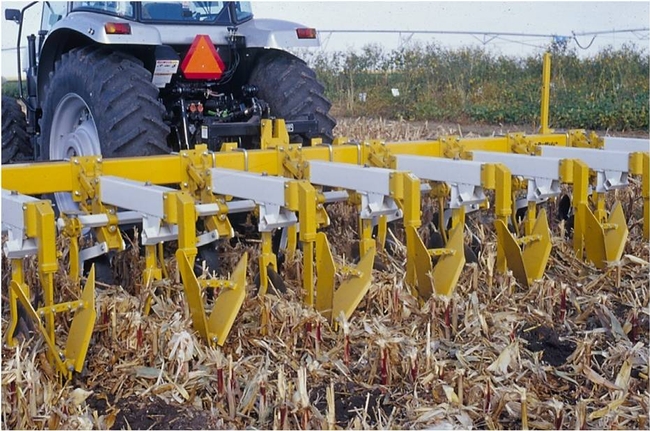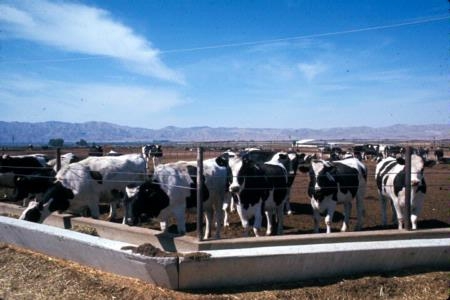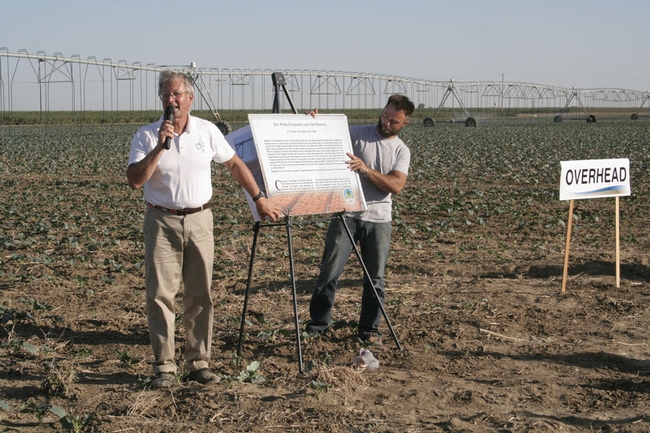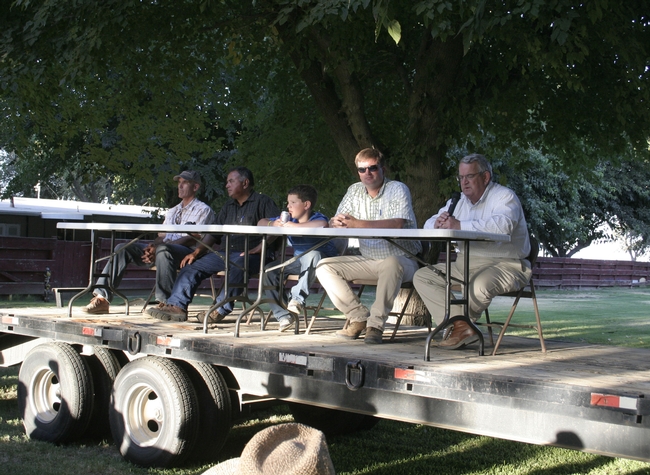Posts Tagged: Jeff Mitchell
Leaving crop residues in the field improves water use efficiency
Managing crop residues to essentially make them disappear has been the norm in California agriculture.
But a growing body of research, and experience with conservation tillage on thousands of acres of Central Valley farmland, is showing that reducing tillage and leaving crop residues on the soil surface can improve water use efficiency.
“Crop residues are an inevitable feature of agriculture,” Jeffrey Mitchell, cropping systems specialist in the Department of Plant Sciences, UC Davis, wrote in the April-June 2012 issue of California Agriculture journal. “Because no harvest removes all material from the field, the remaining plant matter accumulates and is typically returned to the soil through a series of mixing and incorporating operations involving considerable tractor horsepower, an array of tillage implements and cost.”
Conservation tillage is a suite of low-impact cultivation practices that includes leaving crop residues on the soil surface and planting new crops on top, significantly decreasing the number of tractor passes needed to prepare fields for planting. In turn, growers reduce their fuel, labor and maintenance costs, and less dust and pollution gets into the air.
In two field studies conducted at the UC West Side Research and Extension Center in Five Points, no-tillage and standard tillage operations were compared in a corn/wheat rotation. Mitchell and colleagues found that 0.89 and 0.97 inches more water was retained in the no-tillage soil than in the tilled soil.
And in three field studies on crop residue coverage, about 0.56, 0.58 and 0.42 inches more water was retained in residue-covered soil than in bare soil following 6 to 7 days of overhead sprinkler irrigation. The full study results are published in the April-June 2012 California Agriculture journal.
The authors estimated that coupling no-tillage with practices that preserve high residues on the soil surface can reduce evaporative losses during the summer by about 4 inches (13 percent), assuming a seasonal evapotranspiration demand of 30 inches.
In widespread use in other regions of the country, conservation tillage practices appear to be catching on in California. In surveys conducted by Sustainable Conservation and the UC Conservation Agriculture Systems Initiative, the amount of farmland under conservation tillage statewide grew by nearly 20 percent between 2008 and 2010, to about 1 million acres.
Mitchell and colleagues warn that a number of practical factors must be addressed before a wholesale transformation to no-tillage, residue-preserving production can be envisioned in California: “These include the relative ease with which a farm's existing cropping mix might be converted to no-till, the need for and cost of new equipment and the learning curve for new management practices.”
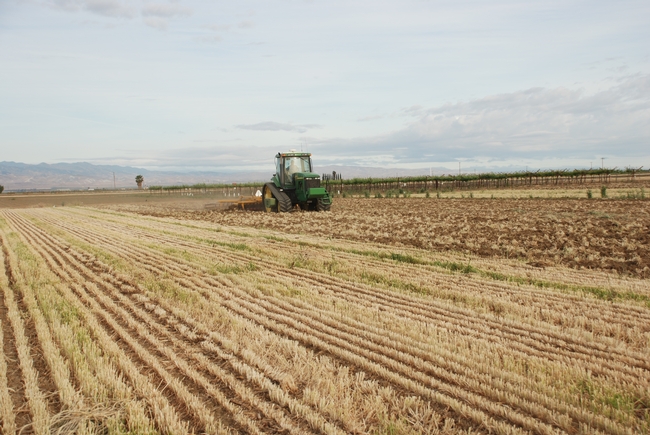
A two-year study compared soil water content in tilled (right, subsoil ripped) and no-tillage (left) plots.
Conservation ag practices highlighted at 'CASI' launch
University of California advisors and specialists, farmers, scientists and agriculture professionals gathered Friday in Clovis to launch a new organization that could potentially save farmers time and money, and reduce their impact on the environment, wrote Robert Rodriguez in the Fresno Bee.
The event marked the establishment of the Conservation Agriculture Systems Institute, which will support research and education efforts to encourage farmers' implementation of conservation agriculture practices.
The Fresno Bee story appeared at the top of the paper's Saturday business page under the headline "UC pushes conservation."
UC Cooperative Extension cropping systems specialist Jeff Mitchell said the U.S. is behind the rest of the world in adopting reduced tillage and conservation practices. But that could change as farmers face increasing regulation.
"We are going to face increased demands to produce more in a way that is less damaging to the environment," Mitchell said. "This is not going to be business as usual anymore. And it's not just about making a profit; it is about optimizing yields and looking at the sustainability of our production methods."
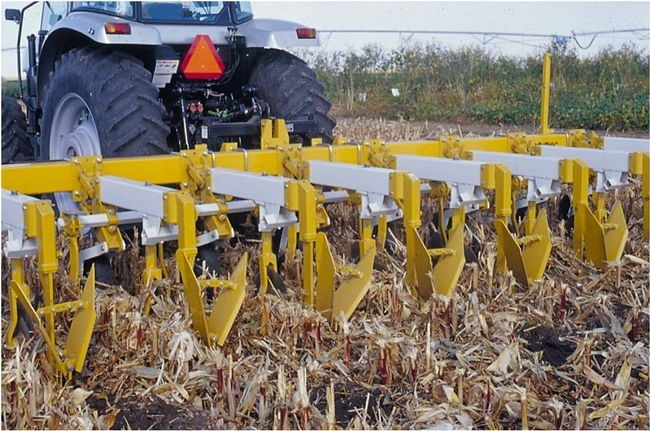
Strip tillage is one example of conservation agriculture.
More farmers trying conservation agriculture
"Let it be" is the mantra of some Central Valley farmers when it comes to turning up the soil, wrote John Holland in the Modesto Bee. Holland was reporting on a recent UC survey that found more farmers are using conservation agriculture practices.
The survey was conducted by UC's Conservation Agriculture Systems Institute, made up of government, academic and environmental partners. It looked at land in nine San Joaquin Valley counties that was planted in silage and grain corn, small grains for hay, tomatoes, cotton, dry beans and melons.
In 2010, conservation tillage systems accounted for about 14 percent of the acreage, an increase from about 10 percent in 2008. Minimum tillage practices were used on about 33 percent of crop acreage in 2010, up from about 21 percent in 2008.
In California, a different problem exists
Stockton Record
In California, 75 to 80 percent of corn is a genetically engineered variety, and much of it carries Bt genes, said Kent L. Brittan, the University of California Cooperative Extension's director for Yolo County and field crops advisor.
The corn seed is purchased for glyphosate tolerance. Seed companies commonly combine the traits in their products, so the Bt genes are part of the package, even though corn rootworm is not a concern for California growers.
"We have the insect; it has never - knock on wood - been a corn pest here in California, so the resistance problem would not be an issue with us," Brittan said.
California conservation tillage acreage increasing
The amount of California farmland being cultivated using conservation tillage techniques is continuing to expand, according to a survey by California’s Conservation Agriculture Systems Institute (CASI).
The survey tallies silage and grain corn; small grains for hay, silage and grain; tomatoes, cotton, dry beans, and melons managed as no-till, strip-till, ridge-till and mulch-till – which leave at least 30 percent of residue from the previous crops on the soil surface – in the nine-county Central Valley region. In 2010, such conservation tillage accounted for about 14 percent of the crops’ total acreage, an increase from about 10 percent in 2008. The survey also found that minimum tillage practices – which reduce the overall number of tillage passes by at least 40 percent relative to what was done in 2000 – were used on about 33 percent of crop acreage in 2010, up from about 21 percent in 2008.
There are many potential benefits for using conservation tillage, said UC Cooperative Extension cropping systems specialist Jeff Mitchell. Conservation tillage is credited with water conservation, dust suppression, reduced pesticide runoff into surface water, lowered labor needs and costs, and fuel savings. In addition, limiting tillage helps to keep carbon in the ground and prevent the buildup of greenhouse gases in the atmosphere.
CASI has conducted comparisons of annual row crop acreage farmed under different tillage systems in the Central Valley region since 2004. More than 35 Natural Resources Conservation Service, University of California and private sector experts take part in the survey.
The largest change in conservation tillage acreage from 2004 to 2010 is found in the amount of corn silage acreage that uses strip-tillage. In 2004, there were only about 490 acres of summer silage corn using strip-till, while in 2010 more than 103,000 acres in the San Joaquin Valley dairy region had adopted this form of conservation tillage. The overall use of minimum tillage practices has also greatly increased during this time from about 64,000 acres under reduced pass tillage in 2004 and just over 700,000 acres under minimum tillage in 2010.
California’s Conservation Agriculture Systems Institute involves more than 1,500 farmers, industry representatives, university, Natural Resource Conservation Service and other public agency members. Over the past 10 years, the team has come together to develop information on the costs and benefits of the production system and irrigation management alternatives and to develop long-term sustainability goals. For more information on the body of CT research, see the UC Conservation Tillage website.
The body of CT research knowledge continues to grow
UC scientists presented recent additions to the growing body of research on conservation tillage in California at the second annual Twilight Conservation Tillage and Cropping Systems field day last month, demonstrating progress in agricultural systems that will help farmers cut production costs, reduce soil disturbance and save water.
UC scientists and their partner farmers are conducting research that addresses the current needs of the San Joaquin Valley agricultural industry and research that is looking to the future by anticipating changes that may need to be negotiated in coming decades.
During the field day at UC's West Side Research and Extension Center in Five Points, Calif., participants visited two primary research areas. The first is the longest-standing conservation ag system study in California, where a cotton/tomato rotation has been farmed for 12 years running. The plots include standard tillage with and without cover crops and conservation tillage with and without cover crops.
“This might be the most-visited research field in California,” said Jeff Mitchell, UC Cooperative Extension vegetable crops specialist and chair of the CT workgroup. “Many students and scientists have conducted research here.”
For example, scientists have been able to quantify significant improvements in soil quality with the use of cover crops and conservation tillage. UC Davis soil biochemist Will Horwath reported that conservation tillage combined with an off-season cover crop has increased the soil carbon content close to five tons per hectare.
“Is that significant?” Horwath asks. “Yes. In 10 years, we have almost doubled the soil carbon content.”
Because of the valley’s dry, hot climate, the native soils are typically very low in carbon, which is a characteristic of low soil quality. Carbon in the soil acts as a glue, helping reduce wind erosion.
At the second research field, conservation tillage research is being combined with overhead and subsurface drip irrigation. Coupling overhead irrigation with conservation tillage is common in other regions of the U.S., but is just beginning to get attention in California.
“There are more than 17,000 center pivots in the state of Nebraska, and it is estimated that there are somewhere between 300 and 500 pivots currently in use in California, the No. 1 ag state in the nation,” Mitchell said. “This situation is changing rapidly.”
Overhead irrigation is efficient, automated, allows for diverse cropping and, with soil residues from conservation tillage, permits uniform infiltration.
Four users of overhead irrigation shared their experiences with the irrigation system at the field day. West side farmer John Deiner said mechanized irrigation has significantly reduced labor input in his agronomic crops while boosting crop yields.
“Our corn grew two to three feet taller under the pivot,” he said.
Will Taylor of King City grows potatoes for In and Out Burger under center pivots. He said his yields are 20 percent higher when using the overhead irrigation system.
“Once you overcome challenges,” Taylor said, “they’re awesome.”
He demonstrated their ease of use by bringing along his 9-year-old son Liam, whom he said can already manage the machine.
Darryl Cordova of Denair uses overhead irrigation in a hilly area on the east side of the valley.
“What used to take three guys six hours of moving pipe is now done with a push of a button on my cell phone,” Cordova said.
Scott Schmidt, who farms across the street from the West Side Research and Extension Center, said he has learned how to successfully use overhead irrigation and conservation tillage from the “school of hard knocks.”
“Most of the problems have been self-inflicted wounds,” Schmidt said. But now, he calls the system “flawless.” “We have seven pivots that I operate remotely from my phone.”


